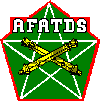 AFATDS is a totally integrated fire support C2 system designed to replace TACFIRE. It
processes fire mission and other related information to coordinate and optimize the use of
all fire support assets, including mortars, field artillery, cannon, missile, attack
helicopters, air support, and naval gunfire. AFATDS will provide processing capabilities
from the corps to the platoon Fire Direction Center.
AFATDS is a totally integrated fire support C2 system designed to replace TACFIRE. It
processes fire mission and other related information to coordinate and optimize the use of
all fire support assets, including mortars, field artillery, cannon, missile, attack
helicopters, air support, and naval gunfire. AFATDS will provide processing capabilities
from the corps to the platoon Fire Direction Center.
Through the use of distributed processing capabilities, fire missions will flow through the fire support chain during which target attack criteria will be matched to the most effective weapon systems available at the lowest echelon. The automation provided by AFATDS will enhance the maneuver commander's ability to dominate the battle by providing the right mix of firing platforms and munitions to defeat enemy targets based on the commander's guidance and priorities. AFATDS also expands the fire support commander's ability to control assets and allocate resources.
AFATDS will automate and facilitate fire support planning and current operations. During battle, AFATDS will provide up-to-date battlefield information, target analysis, and unit status, while coordinating target damage assessment and sensor operations.
Integrating all fire support systems via a distributed processing system will create a greater degree of tactical mobility for fire support units and allow missions to be planned and completed in less time. AFATDS will also meet field artillery needs by managing critical resources; supporting personnel assignments; collecting and forwarding intelligence information; and controlling supply, maintenance, and other logistical functions.
AFATDS will interoperate with all fire support systems and ATCCS BFACS, as well as the fire support C2 systems for Germany (i.e., ADLER), United Kingdom (i.e., BATES), and France (i.e., ATLAS).
AFATDS will use modular applications software under development, in conjunction with ATCCS CHS. Major hardware components will be the Fire Support Control Terminal (FSCT) and the Fire Support Terminal (FST).
The processing and hand-over of targets within AFATDS and ASAS needs to be refined. Currently, target selection standards in the AFATDS are unworkable and do not truly facilitate fires. The AFATDS provides the operator with the ability to assign minimum standards for target location error (TLE) and time acquired. These standards apply across the thirteen target categories and ninety-six target types, but a problem arises when operators need to establish standards for moving and stationary versions of the same target type. Currently, AFATDS does not support both activities. To make matters worse the ASAS does not send TLE, acquisition times, target speed, or proper target types. Now for those nay sayers, ASAS actually can send the proper target type after a fifteen step manual work around is accomplished, and AFATDS currently really has no use for moving target data even if it is sent. Both the ASAS and the AFATDS possess tremendous potential to aid in the targeting process and during delivery of fires, but the process of sharing critical targeting data between these two systems is essential to success.

